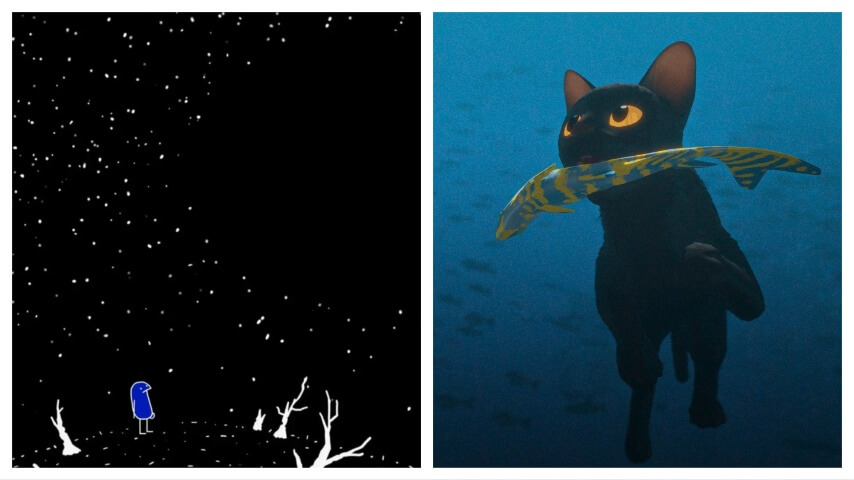Dialogue-free animation is entering a new golden age
Titles like Robot Dreams, Flow, ME, and more are allowing animation to quietly flourish.
Image: Bitter Films (L), Sideshow and Janus Films (R)
From its inception in 1908 with Émile Cohl’s Fantasmagorie, film animation has always been a medium that esteems the conveyance of visuals, by its very definition. As animation as we know it has evolved in its 116 years of official existence, animators have consistently used the medium as an incubator for experimentation—to play with the alchemy of how you can tell stories. The purest pursuit of the medium, dialogue-free animation, goes back to this origin. But the modern commercialization of animated feature production has meant studios and executives have been less generous in letting animators pare back the chatter, and just show the story.
That makes this decade’s relative spate of mainstream, dialogue-free or dialogue-lite animation a surprising delight; we might even deem it a mini golden age of dialogue-free storytelling. The format featuring the most creative freedom—animated short films—is influencing more mainstream projects, like Kirsten Lepore’s I Am Groot series for Marvel Studios. Legends in the field, like independent filmmaker Don Hertzfeldt, are still making magic in the format. Hertzfeldt’s latest short, ME, is an experimental, non-dialogue musical about narcissism. Genndy Tartakovsky went feral with his bloody, elegant Adult Swim series Primal. Even recent feature films have bucked the norms and triumphed: Pablo Berger’s Oscar-nominated Robot Dreams, large sections of DreamWorks Animation’s The Wild Robot and Netflix’s upcoming Wallace & Gromit: Vengeance Most Fowl, and Gints Zilbalodis’ Flow (out this week) all eschew dialogue.
For a form that has such a long and rich history, literally built upon the bedrock idea of encouraging unfettered imagination to be transformed into moving images, the slow march by mainstream studios to shoehorn animation into formulaic and tired templates like the rest of the industry is depressing. And yet it’s no question that, in an abysmal development year in Hollywood, feature animation has been one the most successful sectors. So why is animation being discouraged from leaning into the very thing it’s long succeeded at? In theory, including less dialogue in a mainstream animated film helps distributors sell it to international audiences who won’t have to contend with a language barrier. A visually-led story is more accessible by all standards. But consistently, up through November of this year, the highest grossing animated films commissioned by studios and streamers remain very, very chatty.
“If I’m a distributor with an international film on my hands, I’m going to sleep a little easier at night if it doesn’t have any dialogue in it,” Don Hertzfeldt tells The A.V. Club.
“As cinema becomes more and more globalized, anything without dialogue is going to be a much easier sell across borders,” he continues. “In the silent film era, we were a nation of immigrants fresh off the boat with cities full of different communities who couldn’t speak the same language. But anyone could go buy a ticket and understand Charlie Chaplin. For the same reason, a film today that has no language barrier will probably have a better chance internationally. And every time I see a Miyazaki film, I wish I could speak Japanese.”
For two decades, Hertzfeldt has built a knockout portfolio of inventive and thought-provoking films that consistently win piles of awards and the admiration of his peers. From 2000’s seminal Rejected to the recent World Of Tomorrow series of shorts, Hertzfeldt goes where his imagination takes him, and the audience follows.
In ME, Hertzfeldt returns to dialogue-free storytelling and tells The A.V. Club that it was all about rising to the challenge of a self-imposed creative exercise. “Most of my movies are full of characters who won’t shut up,” he said. “I sometimes think that I’m a writer above all else, but I also don’t like the idea of making the same film twice. ME was a good excuse to exercise some other muscles. My rules for ME were no dialogue, no written words on the screen, and no sound effects. Sometimes creative limitations, even when they’re self-inflicted, can make interesting things happen. I don’t agree with the idea that silent films are more ‘pure’ or anything, but there can definitely be something special about them—like watching a poem.”
An animator who has stayed inside the studio system and been able to balance his own quest to challenge himself with the needs of his bankrollers is Genndy Tartakovsky. With his Hotel Transylvania trilogy for Sony Animation, he made mainstream comedies as reliant on dialogue as any. Yet on the smaller screen with Cartoon Network and Adult Swim, he’s been able to throw elbows at typical creative limitations and create series that don’t adhere to the typical animated series fare. But Tartakovsky’s work also gets eyes. His penchant for experimenting with dialogue-lite storytelling was fostered during the years making Samurai Jack and Star Wars: Clone Wars, and is now showcased with Primal. However, even Tartakovsky isn’t immune from the industry; his upcoming R-rated film Fixed has been a victim of Warner Bros. Discovery cost-cutting, leaving Sony Animation alone to find a distributor.

 Keep scrolling for more great stories.
Keep scrolling for more great stories.